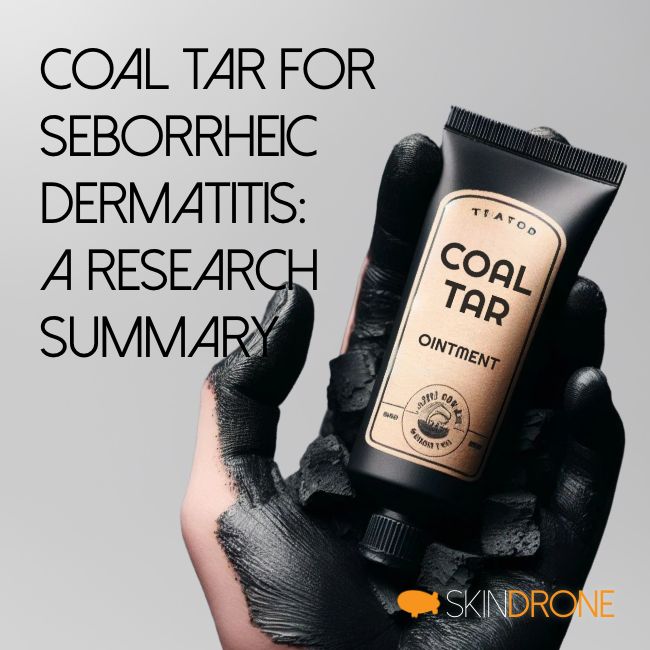- Coal tar is a time-tested treatment for seborrheic dermatitis and dandruff, used for over a century.
- It works by reducing skin cell overgrowth, inflammation, sebum production, and fighting fungi.
- Research supports its antifungal effects and overall effectiveness, comparable to other treatments.
- While safe for most, it has drawbacks like odor and staining that should be considered.
- Other tar types exist, but coal tar is the most researched for skin conditions.
Coal tar is a long-established topical treatment in dermatology, effectively used for skin conditions such as psoriasis, eczema, and seborrheic dermatitis (commonly known as dandruff). This article dives into the science behind coal tar and its application for managing seborrheic dermatitis.

What is Coal Tar?
Coal tar is a thick, dark liquid created as a byproduct of coal’s conversion into coke or gas [1]. It’s a complex mixture containing over 10,000 different chemical compounds, including polycyclic aromatic hydrocarbons (PAHs) [2].
For over 150 years, coal tar has been used medicinally due to its diverse properties. It acts as an anti-inflammatory, antibacterial, antifungal, antipruritic (anti-itch), and keratoplastic agent, meaning it helps regulate skin cell growth [3, 4].

How Coal Tar Works for Seborrheic Dermatitis
Coal tar’s effectiveness in treating seborrheic dermatitis stems from its multi-faceted mechanism of action:
- Reduces Skin Cell Overproduction: It slows down the rapid skin cell turnover that is characteristic of both psoriasis and seborrheic dermatitis [2].
- Decreases Inflammation: Coal tar helps to normalize inflammation by reducing the production of cytokines and chemokines [5].
- Regulates Sebum Levels: Seborrheic dermatitis is often associated with increased sebum (skin oil) production. Coal tar assists in bringing sebum production back to a normal level [2].
- Fights Fungal Infections: It exhibits antifungal properties against Malassezia yeasts, which are known to play a significant role in seborrheic dermatitis [3].

Research on Antifungal Efficacy
Two notable studies have investigated coal tar’s antifungal capabilities:
- 1993 Study: This research compared a coal tar gel against ketoconazole gel, a common antifungal medication, for treating Malassezia yeast. The study found that both gels demonstrated similar levels of effectiveness [6].
- 1995 Study: This study assessed coal tar’s effect on various Malassezia yeast strains. While coal tar’s ability to inhibit fungal growth varied across strains (MIC 3-50 μm/ml) and was less potent than zinc pyrithione and selenium sulfide, it’s important to note that coal tar is typically used in higher concentrations in practical treatments [3].
These studies suggest that while not the strongest antifungal agent, the concentrations of coal tar used in treatments are likely sufficient to combat Malassezia and contribute to its therapeutic effect.

Coal Tar Safety and Side Effects
With over 150 years of clinical use, topical coal tar has a well-documented safety record:
- Long-Term Safety: Decades-long studies have not identified any significant long-term safety concerns associated with topical coal tar use [7].
- Common Side Effects: The most frequently reported side effects are generally mild and can include skin irritation, increased sun sensitivity, folliculitis (inflammation of hair follicles), and allergic contact dermatitis [8].
Initial concerns about skin cancer risk arose due to the PAH content in coal tar. However, robust epidemiological studies have not established a clear link between topical coal tar use and an increased risk of skin or internal cancers [8, ].
While not entirely without risks, coal tar appears to be a relatively safe option for topical application when used under medical guidance.

Coal Tar vs. Other Tar Types
Besides coal tar, other types of tars are also used in medicine:
- Pine Tar: Derived from pine wood, pine tar is mainly used for skin and respiratory issues. It has less scientific research backing compared to coal tar [9].
- Sulfonated Shale Oil: This is a byproduct of the shale oil industry and is used for conditions like psoriasis, eczema, and seborrheic dermatitis. It’s often considered to have a more favorable safety profile than coal tar [10].
These alternative tars might offer similar benefits to coal tar for seborrheic dermatitis, though research may be less extensive.

Downsides of Using Tar Treatments
The primary disadvantages associated with coal tar and other tar-based treatments include:
- Strong Odor: Tars have a distinct, strong smell that often necessitates the addition of fragrances to mask it. These fragrances can sometimes cause allergic reactions [8].
- Staining: Tar preparations can leave dark stains on both skin and clothing [2].
These factors have likely contributed to a decrease in the popularity of tar-based treatments compared to newer, more cosmetically appealing, colorless, and fragrance-free alternatives.

In Conclusion
- Coal tar is a well-established treatment for skin conditions, with strong evidence supporting its effectiveness for seborrheic dermatitis.
- Its benefits come from multiple actions: reducing inflammation, regulating skin cell and sebum production, and antifungal properties.
- Decades of use have confirmed a good safety profile for coal tar, with minor irritation being the most common side effect.
- However, its strong odor and staining potential are drawbacks that may make some individuals prefer alternative treatments.
While not typically the first-line treatment choice, coal tar remains a viable and research-supported option for managing seborrheic dermatitis under medical supervision. Other tar preparations might offer similar advantages with potentially better tolerability and safety profiles, suggesting a need for more comparative studies to fully understand their respective benefits and risks.

No Comments
Be the first to start a conversation